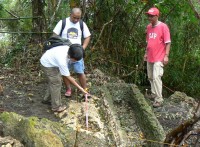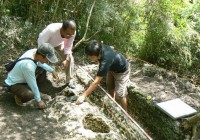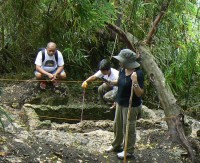 Archaeologists from the National Museum of the Philippines have discovered the remains of an ancient village in the jungles of Mount Kamhantik near the town of Mulanay in Quezon province. Along with evidence of habitation, 15 rectangular coffins were found carved directly into limestone outcroppings in the jungle floor. A human tooth found inside one of the limestone tombs was radiocarbon dated in the U.S. and is at least 1000 years old.
Archaeologists from the National Museum of the Philippines have discovered the remains of an ancient village in the jungles of Mount Kamhantik near the town of Mulanay in Quezon province. Along with evidence of habitation, 15 rectangular coffins were found carved directly into limestone outcroppings in the jungle floor. A human tooth found inside one of the limestone tombs was radiocarbon dated in the U.S. and is at least 1000 years old.
There are no other burial sites of that age in the Philippines which feature carved stone coffins. Other archaeological sites from that period have been found with wooden coffins, earthen burials and pottery jar burials, but carving limestone requires greater technological advancement. Metal tools had to have been used, and this is the earliest evidence of people using metal tools to carve limestone tombs found in the Philippines.
 According to a National Museum report, overall the village remains range in date from the 10th to the 14th century. Archaeologists have also found pottery shards, metal artifacts and fragments of bones from humans and animals in the coffins. Postholes carved into the limestone indicate dwellings were once erected over the jungle floor. They’ve only uncovered a small section of the estimated 12-acre site over the past year. Excavations will continue over the next few years.
According to a National Museum report, overall the village remains range in date from the 10th to the 14th century. Archaeologists have also found pottery shards, metal artifacts and fragments of bones from humans and animals in the coffins. Postholes carved into the limestone indicate dwellings were once erected over the jungle floor. They’ve only uncovered a small section of the estimated 12-acre site over the past year. Excavations will continue over the next few years.
 The archaeological site is part of a larger 700-acre forest which was declared a protected ecological site by the government in 1998. The jungle at the base of Mount Kamhantik has been cleared for farming and habitation and the rest of the mountain was also in danger from slash-and-burn clearings. Since it is one of few remaining habitats for rare animals like cave bats and hornbills, the government placed the endangered mountain under protection to keep the thick forest intact.
The archaeological site is part of a larger 700-acre forest which was declared a protected ecological site by the government in 1998. The jungle at the base of Mount Kamhantik has been cleared for farming and habitation and the rest of the mountain was also in danger from slash-and-burn clearings. Since it is one of few remaining habitats for rare animals like cave bats and hornbills, the government placed the endangered mountain under protection to keep the thick forest intact.
Looters also did a number on the mountain years ago. In fact, it was treasure hunters who first exposed some of the limestone tombs looking for gold and other easily salable artifacts. It wasn’t until last year that archaeologists finally got a chance to explore the area and uncover more tombs and artifacts of major archaeological significance which are worthless on the antiquities market, like that tooth.
 The people in the nearby town of Mulanay are very excited about this find. Despite the natural beauty of the area, the town’s location at the foothills of the mountain on an uninterrupted six-mile strip of sandy beach on Tayabas Bay (headquarters of the 16th century Chinese pirate Lim Hong who used to dock there to bury his treasure before heading out for more pirating) with a coral reef 150 feet from the shore, and inland waterfalls surrounding a unique rock formation the locals use for picnics, Mulanay is still known more for battles between the army and the Maoist New People’s Army that took place there in years past. Mayor Joselito Ojeda hopes this discovery will finally erase that association and open the door to new ecotourism opportunities that will provide a much needed infusion of cash to the impoverished area.
The people in the nearby town of Mulanay are very excited about this find. Despite the natural beauty of the area, the town’s location at the foothills of the mountain on an uninterrupted six-mile strip of sandy beach on Tayabas Bay (headquarters of the 16th century Chinese pirate Lim Hong who used to dock there to bury his treasure before heading out for more pirating) with a coral reef 150 feet from the shore, and inland waterfalls surrounding a unique rock formation the locals use for picnics, Mulanay is still known more for battles between the army and the Maoist New People’s Army that took place there in years past. Mayor Joselito Ojeda hopes this discovery will finally erase that association and open the door to new ecotourism opportunities that will provide a much needed infusion of cash to the impoverished area.